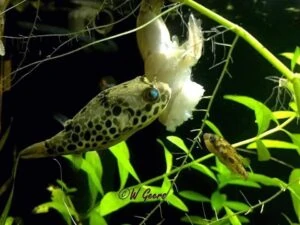Ctenopoma acutirostre – Spotted ctenopoma
Ctenopoma acutirostre – Spotted ctenopoma is a robust climbing perch found throughout the Congo River basin in Congo and CAR and grows up to 15 cm. The fish resembles Ctenopoma ocellatum and Ctenopoma kingsleyae, but is distinguished by the strong spot pattern and the more spiny fin rays on the dorsal fin. Young specimens are lighter colored with some dark brown spots. As the animals age, the basic color changes to chocolate brown with an even greater number of dark spots. Adult animals turn more evenly brown as they mature.
Unlike Ctenopoma kingsleyae (a fast swimmer), Ctenopoma acutirostre moves quietly and cautiously. Like the other members of the genus Ctenopoma, it is a nocturnal species by nature and, from ambush, has the ability to protrude its mouth to capture and swallow small prey.
Please note that catching and transporting the Spotted ctenopoma with a net is not recommended as this fish is well-armed with a series of spines on the posterior part of the gill covers and hard fin rays of the dorsal fin. The fish also owes its Latin name to the spines: acutirostre: acutus, meaning ‘sharp’, and rostrum, meaning ‘snout’. Males have a greater number of spines on the gill covers and a coarser scale structure at the base of the tail.
Closely related to the Climbing Gouramies (genus Anabas), these fish also have the ability to move over land for short periods of time, moving from one waterhole to another. The indigenous people of Zimbabwe have many legends and superstitions regarding the overland movement of these fish species. Their ancestors believed that these “Bushfish” (a description given to all Ctenopoma species by their similarity to floating leaves and driftwood) fell with the rain, as it is not uncommon for species to be found many miles from the nearest waterhole in the hours after a heavy rain period. Fortunately, and unlike other members of their genus, the Spotted ctenopoma does not have a reputation for imitating dead leaves in aquariums, although a good cover is recommended to prevent potential escape attempts.
Description
With their independently moving eyes, the Spotted ctenopoma moves cautiously through the dense vegetation in search of prey to stalk. The prey is sucked in through an extendable mouth. In adult specimens, fish the size of 3 to 4 centimeters are not safe. Larger fish are left alone. The species is not aggressive towards other species and can be combined well with other larger and non-aggressive fish. Preferably keep the fish as a couple, because males show more aggressiveness with each other. A Spotted ctenopoma can live up to 15 years. As the fish mature, they become more shy and also more territorial. Sometimes they suddenly no longer tolerate their partner in their territory.
In the aquarium trade, this species is also called the Spotted ctenopoma. Other synonyms are: Anabas acutirostris, Anabas ocellatus acutirostris, Ctenopoma acutirostris.
The Aquarium
Ctenopoma acutirostre needs a spacious aquarium, 90x40x40 is really the minimum size. Remember to follow the air space rule for labyrinth fish and therefore leave a space of 2.5 cm between the water and the aquarium lid. If the Spotted ctenopoma does not have the opportunity to breathe, it will not be able to function optimally and its labyrinth organ will drown.
The Spotted ctenopoma does well at a pH of 7.5 and a temperature of 25 Celsius. It is important that they have a number of hiding places, for example through tall plants and wood. Moderate lighting with possibly floating plants is appreciated and ensures that they also feel comfortable during the day. Plant the aquarium densely, the species likes to maneuver cautiously through dense vegetation to stalk its prey. The fish is not aggressive towards other fish species but is able to defend its territory when necessary. However, do not combine the fish with aggressive cichlid species.
Diet
In nature, the Spotted ctenopoma mainly feeds on insects (larvae) and small fish. In most cases, it is easy to get them to eat frozen food or larger granules. Do not feed beef because it contains components that cannot be digested and lead to fat storage
Breeding
Few breeding cases of the Ctenopoma acutirostre – Spotted ctenopoma are known. It is thought that they only reach sexual maturity after 5 or 10 years. It is also possible that the urge to mate is seasonal and may be prompted by changes in the living environment. The eggs float to the surface where they hang between the plants. The parents show no brood care. The eggs hatch after 48 hours. The young can be raised for the first few days on infusoria, followed by freshly hatched brine shrimp.
Video
Author
Patrick de Pijper
Copyright images
Patrick de Pijper
Resources









Reviews
There are no reviews yet.